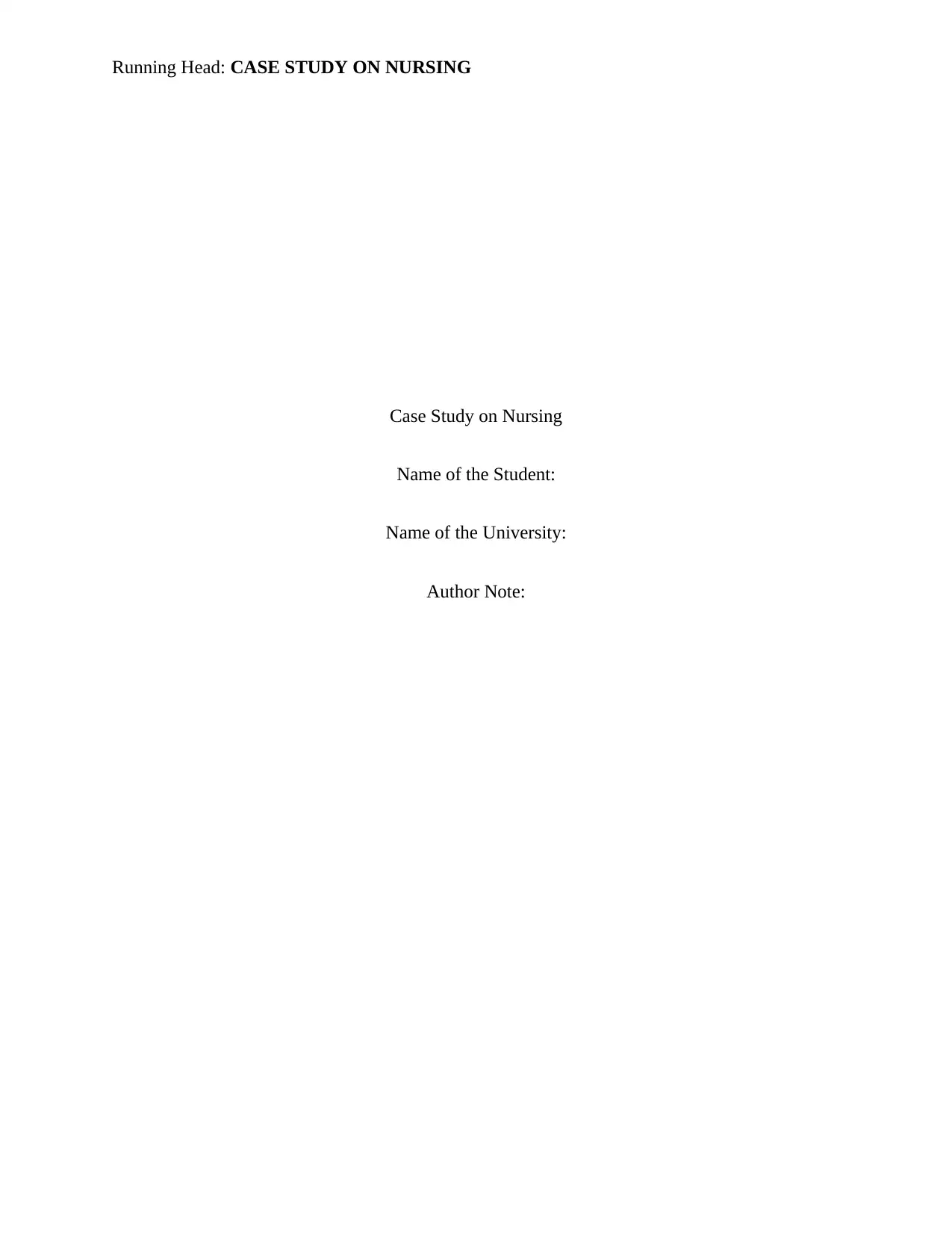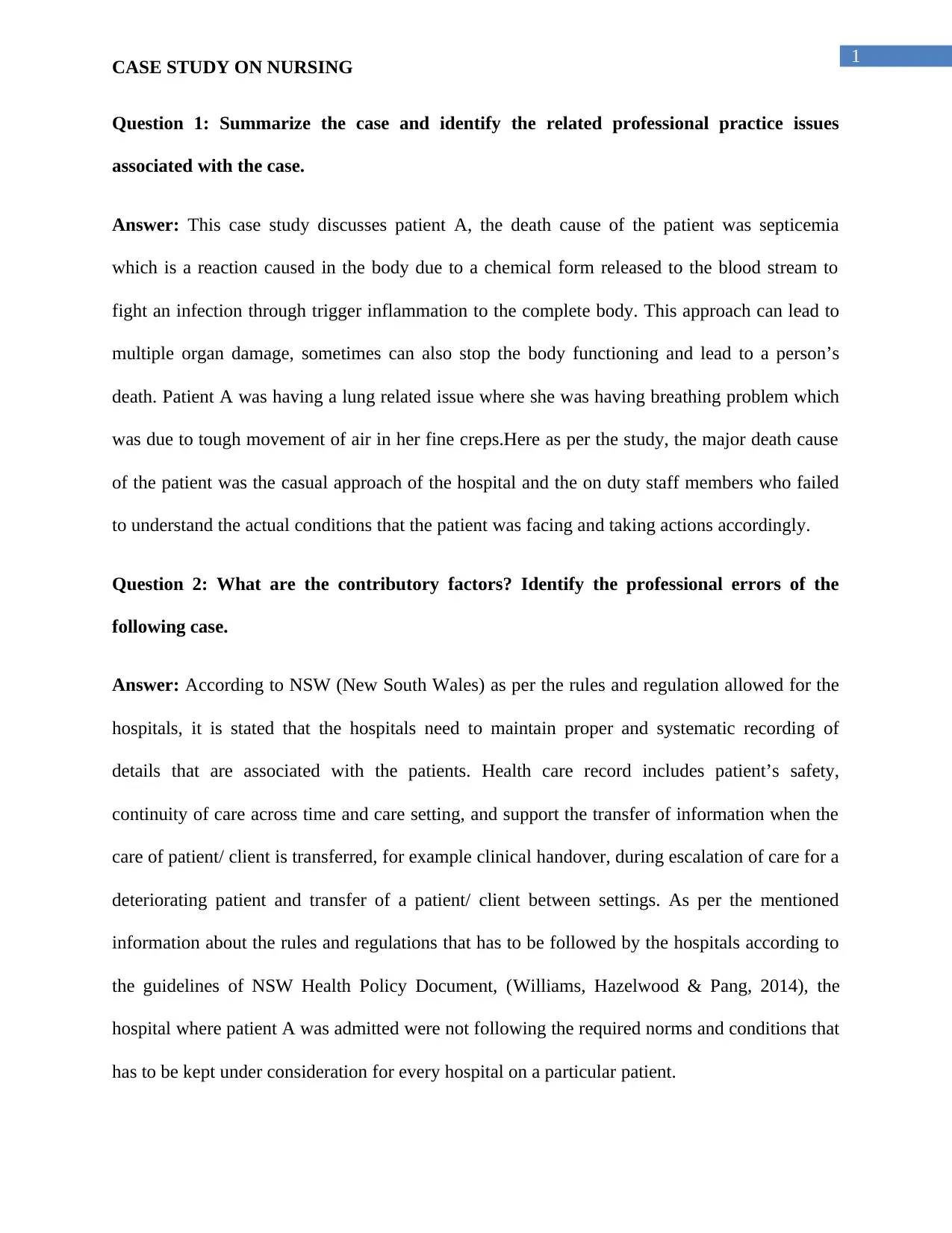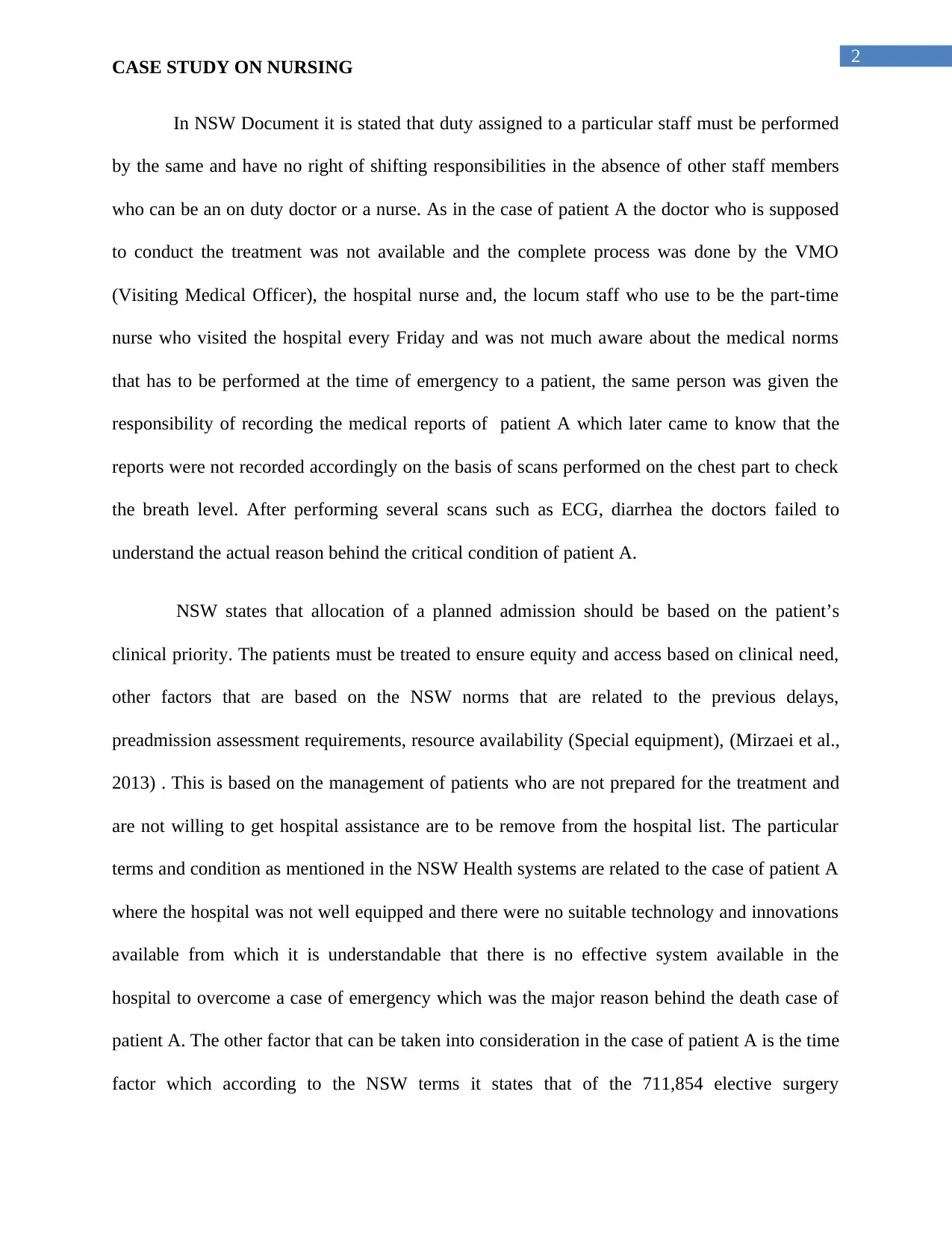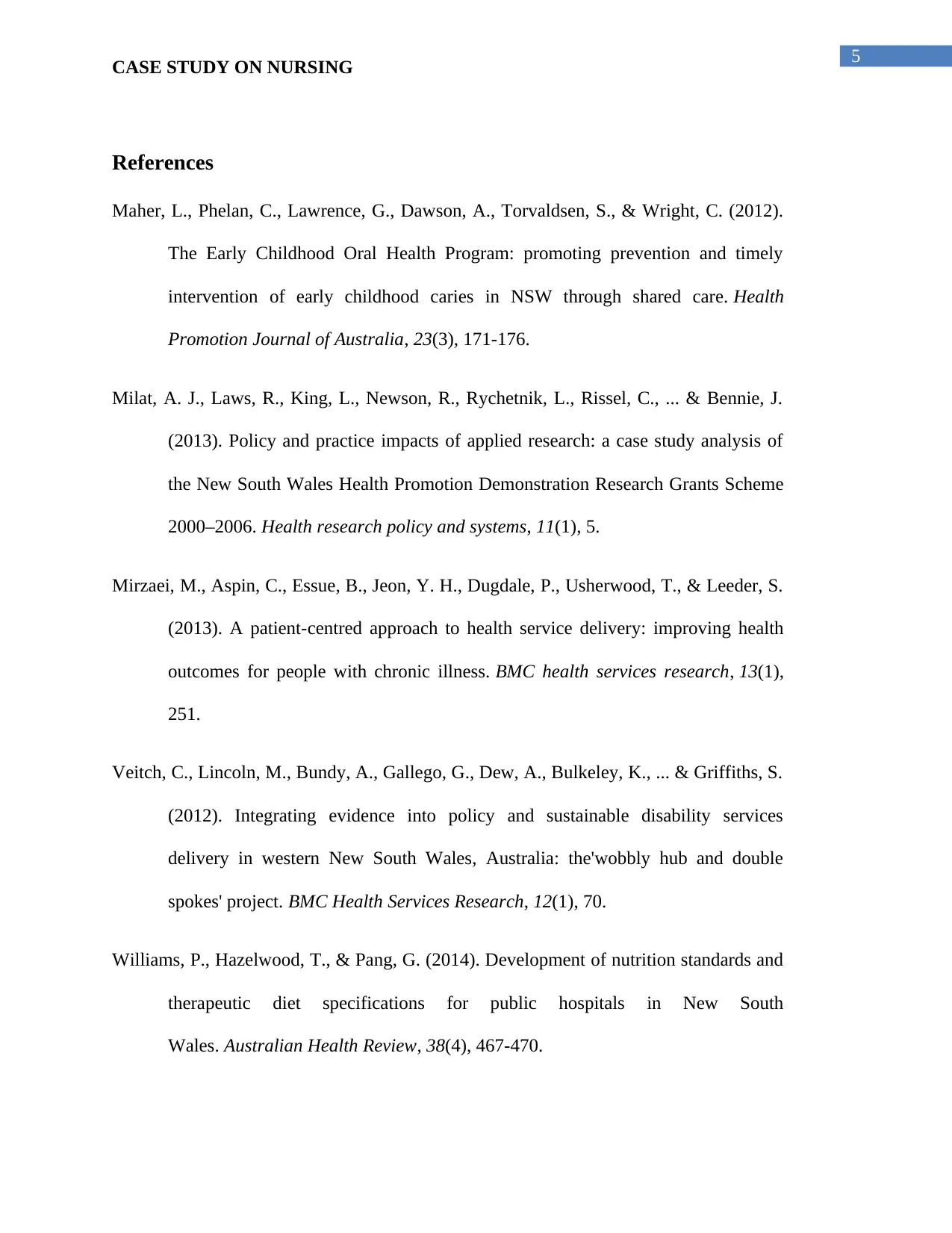401021 Case Study: Nursing Errors and Implications
VerifiedAdded on 2023/01/04
|6
|1459
|81
Case Study
AI Summary
This case study analyzes the treatment of Patient A, who presented with breathlessness and was later diagnosed with septicemia, ultimately leading to her death. The assignment identifies critical professional practice issues, including failures in diagnosis, inadequate monitoring, and adherence to NSW Health policies. Contributory factors included delays in treatment, lack of appropriate technology, and potential errors by healthcare staff. The study references NSW Health guidelines to support its findings. The implications for future practice emphasize the importance of improved management systems, technological advancements, and rigorous adherence to established medical protocols. The student discusses how their own practice would change, focusing on enhanced patient safety measures and continuous professional development to prevent similar incidents.

Running Head: CASE STUDY ON NURSING
Case Study on Nursing
Name of the Student:
Name of the University:
Author Note:
Case Study on Nursing
Name of the Student:
Name of the University:
Author Note:
Paraphrase This Document
Need a fresh take? Get an instant paraphrase of this document with our AI Paraphraser

1
CASE STUDY ON NURSING
Question 1: Summarize the case and identify the related professional practice issues
associated with the case.
Answer: This case study discusses patient A, the death cause of the patient was septicemia
which is a reaction caused in the body due to a chemical form released to the blood stream to
fight an infection through trigger inflammation to the complete body. This approach can lead to
multiple organ damage, sometimes can also stop the body functioning and lead to a person’s
death. Patient A was having a lung related issue where she was having breathing problem which
was due to tough movement of air in her fine creps.Here as per the study, the major death cause
of the patient was the casual approach of the hospital and the on duty staff members who failed
to understand the actual conditions that the patient was facing and taking actions accordingly.
Question 2: What are the contributory factors? Identify the professional errors of the
following case.
Answer: According to NSW (New South Wales) as per the rules and regulation allowed for the
hospitals, it is stated that the hospitals need to maintain proper and systematic recording of
details that are associated with the patients. Health care record includes patient’s safety,
continuity of care across time and care setting, and support the transfer of information when the
care of patient/ client is transferred, for example clinical handover, during escalation of care for a
deteriorating patient and transfer of a patient/ client between settings. As per the mentioned
information about the rules and regulations that has to be followed by the hospitals according to
the guidelines of NSW Health Policy Document, (Williams, Hazelwood & Pang, 2014), the
hospital where patient A was admitted were not following the required norms and conditions that
has to be kept under consideration for every hospital on a particular patient.
CASE STUDY ON NURSING
Question 1: Summarize the case and identify the related professional practice issues
associated with the case.
Answer: This case study discusses patient A, the death cause of the patient was septicemia
which is a reaction caused in the body due to a chemical form released to the blood stream to
fight an infection through trigger inflammation to the complete body. This approach can lead to
multiple organ damage, sometimes can also stop the body functioning and lead to a person’s
death. Patient A was having a lung related issue where she was having breathing problem which
was due to tough movement of air in her fine creps.Here as per the study, the major death cause
of the patient was the casual approach of the hospital and the on duty staff members who failed
to understand the actual conditions that the patient was facing and taking actions accordingly.
Question 2: What are the contributory factors? Identify the professional errors of the
following case.
Answer: According to NSW (New South Wales) as per the rules and regulation allowed for the
hospitals, it is stated that the hospitals need to maintain proper and systematic recording of
details that are associated with the patients. Health care record includes patient’s safety,
continuity of care across time and care setting, and support the transfer of information when the
care of patient/ client is transferred, for example clinical handover, during escalation of care for a
deteriorating patient and transfer of a patient/ client between settings. As per the mentioned
information about the rules and regulations that has to be followed by the hospitals according to
the guidelines of NSW Health Policy Document, (Williams, Hazelwood & Pang, 2014), the
hospital where patient A was admitted were not following the required norms and conditions that
has to be kept under consideration for every hospital on a particular patient.

2
CASE STUDY ON NURSING
In NSW Document it is stated that duty assigned to a particular staff must be performed
by the same and have no right of shifting responsibilities in the absence of other staff members
who can be an on duty doctor or a nurse. As in the case of patient A the doctor who is supposed
to conduct the treatment was not available and the complete process was done by the VMO
(Visiting Medical Officer), the hospital nurse and, the locum staff who use to be the part-time
nurse who visited the hospital every Friday and was not much aware about the medical norms
that has to be performed at the time of emergency to a patient, the same person was given the
responsibility of recording the medical reports of patient A which later came to know that the
reports were not recorded accordingly on the basis of scans performed on the chest part to check
the breath level. After performing several scans such as ECG, diarrhea the doctors failed to
understand the actual reason behind the critical condition of patient A.
NSW states that allocation of a planned admission should be based on the patient’s
clinical priority. The patients must be treated to ensure equity and access based on clinical need,
other factors that are based on the NSW norms that are related to the previous delays,
preadmission assessment requirements, resource availability (Special equipment), (Mirzaei et al.,
2013) . This is based on the management of patients who are not prepared for the treatment and
are not willing to get hospital assistance are to be remove from the hospital list. The particular
terms and condition as mentioned in the NSW Health systems are related to the case of patient A
where the hospital was not well equipped and there were no suitable technology and innovations
available from which it is understandable that there is no effective system available in the
hospital to overcome a case of emergency which was the major reason behind the death case of
patient A. The other factor that can be taken into consideration in the case of patient A is the time
factor which according to the NSW terms it states that of the 711,854 elective surgery
CASE STUDY ON NURSING
In NSW Document it is stated that duty assigned to a particular staff must be performed
by the same and have no right of shifting responsibilities in the absence of other staff members
who can be an on duty doctor or a nurse. As in the case of patient A the doctor who is supposed
to conduct the treatment was not available and the complete process was done by the VMO
(Visiting Medical Officer), the hospital nurse and, the locum staff who use to be the part-time
nurse who visited the hospital every Friday and was not much aware about the medical norms
that has to be performed at the time of emergency to a patient, the same person was given the
responsibility of recording the medical reports of patient A which later came to know that the
reports were not recorded accordingly on the basis of scans performed on the chest part to check
the breath level. After performing several scans such as ECG, diarrhea the doctors failed to
understand the actual reason behind the critical condition of patient A.
NSW states that allocation of a planned admission should be based on the patient’s
clinical priority. The patients must be treated to ensure equity and access based on clinical need,
other factors that are based on the NSW norms that are related to the previous delays,
preadmission assessment requirements, resource availability (Special equipment), (Mirzaei et al.,
2013) . This is based on the management of patients who are not prepared for the treatment and
are not willing to get hospital assistance are to be remove from the hospital list. The particular
terms and condition as mentioned in the NSW Health systems are related to the case of patient A
where the hospital was not well equipped and there were no suitable technology and innovations
available from which it is understandable that there is no effective system available in the
hospital to overcome a case of emergency which was the major reason behind the death case of
patient A. The other factor that can be taken into consideration in the case of patient A is the time
factor which according to the NSW terms it states that of the 711,854 elective surgery
⊘ This is a preview!⊘
Do you want full access?
Subscribe today to unlock all pages.

Trusted by 1+ million students worldwide

3
CASE STUDY ON NURSING
admissions across Australia in 2015-2016, the largest volume has undertaken in NSW, with
217,817 admission from the elective surgery waiting list or over 30 percent of the national
volume (Maher et al., 2012). Despite of having the largest volume, 97.1% of patients in NSW
were admitted for surgery within clinically appropriate time frames, this was one of the highest
result achieved across Australia. According to the particular year of 2015-2016 it is mentioned
that percentage of elective surgery patients with wait time longer than 365 days was 2.0% which
was the same as the national rate (Milat et al., 2013) After making a complete body checkup
considering the illness of the patient and the patient was not able to consume any food on a
regular basis. Instead of finding any solution regarding the particular problem, the hospital
authorities were busy in conducting checkup in a weak body knowing the criticality of the
patient. It took a long time for the hospital authorities to complete the entire relevant test
required for the patient and the process that was not required as a part of treatment was also done
which took the patient’s condition to a critical stage, as a result the patient expired at the end.
Question 3: What are the implications and future prospective to be done? Discuss how
your practice might change and develop as a result of this learning.
Answer: The death cause of patient A was septicemia, the hospital authorities failed to diagnose
the actual problem associated to the patient and it is understandable that the particular hospital
where the treatment undertaken for the patient did not have the required technology and effective
management. The operations were not according to the terms and conditions that a medical
department had to follow. For having better stability in the future the hospital authorities must try
to ensure better management system and effective technologies required for its further treatment
methods. The management must also ensure safety to their patients with required facilities.
CASE STUDY ON NURSING
admissions across Australia in 2015-2016, the largest volume has undertaken in NSW, with
217,817 admission from the elective surgery waiting list or over 30 percent of the national
volume (Maher et al., 2012). Despite of having the largest volume, 97.1% of patients in NSW
were admitted for surgery within clinically appropriate time frames, this was one of the highest
result achieved across Australia. According to the particular year of 2015-2016 it is mentioned
that percentage of elective surgery patients with wait time longer than 365 days was 2.0% which
was the same as the national rate (Milat et al., 2013) After making a complete body checkup
considering the illness of the patient and the patient was not able to consume any food on a
regular basis. Instead of finding any solution regarding the particular problem, the hospital
authorities were busy in conducting checkup in a weak body knowing the criticality of the
patient. It took a long time for the hospital authorities to complete the entire relevant test
required for the patient and the process that was not required as a part of treatment was also done
which took the patient’s condition to a critical stage, as a result the patient expired at the end.
Question 3: What are the implications and future prospective to be done? Discuss how
your practice might change and develop as a result of this learning.
Answer: The death cause of patient A was septicemia, the hospital authorities failed to diagnose
the actual problem associated to the patient and it is understandable that the particular hospital
where the treatment undertaken for the patient did not have the required technology and effective
management. The operations were not according to the terms and conditions that a medical
department had to follow. For having better stability in the future the hospital authorities must try
to ensure better management system and effective technologies required for its further treatment
methods. The management must also ensure safety to their patients with required facilities.
Paraphrase This Document
Need a fresh take? Get an instant paraphrase of this document with our AI Paraphraser

4
CASE STUDY ON NURSING
CASE STUDY ON NURSING

5
CASE STUDY ON NURSING
References
Maher, L., Phelan, C., Lawrence, G., Dawson, A., Torvaldsen, S., & Wright, C. (2012).
The Early Childhood Oral Health Program: promoting prevention and timely
intervention of early childhood caries in NSW through shared care. Health
Promotion Journal of Australia, 23(3), 171-176.
Milat, A. J., Laws, R., King, L., Newson, R., Rychetnik, L., Rissel, C., ... & Bennie, J.
(2013). Policy and practice impacts of applied research: a case study analysis of
the New South Wales Health Promotion Demonstration Research Grants Scheme
2000–2006. Health research policy and systems, 11(1), 5.
Mirzaei, M., Aspin, C., Essue, B., Jeon, Y. H., Dugdale, P., Usherwood, T., & Leeder, S.
(2013). A patient-centred approach to health service delivery: improving health
outcomes for people with chronic illness. BMC health services research, 13(1),
251.
Veitch, C., Lincoln, M., Bundy, A., Gallego, G., Dew, A., Bulkeley, K., ... & Griffiths, S.
(2012). Integrating evidence into policy and sustainable disability services
delivery in western New South Wales, Australia: the'wobbly hub and double
spokes' project. BMC Health Services Research, 12(1), 70.
Williams, P., Hazelwood, T., & Pang, G. (2014). Development of nutrition standards and
therapeutic diet specifications for public hospitals in New South
Wales. Australian Health Review, 38(4), 467-470.
CASE STUDY ON NURSING
References
Maher, L., Phelan, C., Lawrence, G., Dawson, A., Torvaldsen, S., & Wright, C. (2012).
The Early Childhood Oral Health Program: promoting prevention and timely
intervention of early childhood caries in NSW through shared care. Health
Promotion Journal of Australia, 23(3), 171-176.
Milat, A. J., Laws, R., King, L., Newson, R., Rychetnik, L., Rissel, C., ... & Bennie, J.
(2013). Policy and practice impacts of applied research: a case study analysis of
the New South Wales Health Promotion Demonstration Research Grants Scheme
2000–2006. Health research policy and systems, 11(1), 5.
Mirzaei, M., Aspin, C., Essue, B., Jeon, Y. H., Dugdale, P., Usherwood, T., & Leeder, S.
(2013). A patient-centred approach to health service delivery: improving health
outcomes for people with chronic illness. BMC health services research, 13(1),
251.
Veitch, C., Lincoln, M., Bundy, A., Gallego, G., Dew, A., Bulkeley, K., ... & Griffiths, S.
(2012). Integrating evidence into policy and sustainable disability services
delivery in western New South Wales, Australia: the'wobbly hub and double
spokes' project. BMC Health Services Research, 12(1), 70.
Williams, P., Hazelwood, T., & Pang, G. (2014). Development of nutrition standards and
therapeutic diet specifications for public hospitals in New South
Wales. Australian Health Review, 38(4), 467-470.
⊘ This is a preview!⊘
Do you want full access?
Subscribe today to unlock all pages.

Trusted by 1+ million students worldwide
1 out of 6
Related Documents
Your All-in-One AI-Powered Toolkit for Academic Success.
+13062052269
info@desklib.com
Available 24*7 on WhatsApp / Email
![[object Object]](/_next/static/media/star-bottom.7253800d.svg)
Unlock your academic potential
Copyright © 2020–2025 A2Z Services. All Rights Reserved. Developed and managed by ZUCOL.





